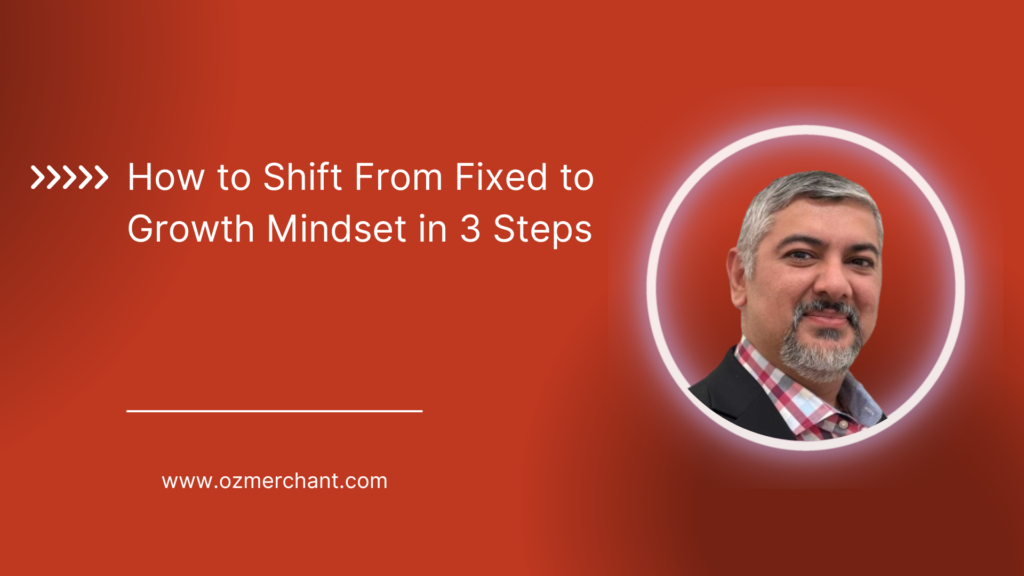Ever feel like you’re stuck in a loop? Like no matter how much you try, some invisible barrier keeps holding you back?
I know I have. Especially in recent years with blockchain, crypto, and AI moving full steam ahead.
For many, it’s not about a lack of skills or talent—it’s about the stories they tell themselves.
“I’m not good at selling.”
“I’ll never understand numbers.” (I hear this one a lot from entrepreneurs)
“I just don’t have what it takes.”
Sound familiar?
These aren’t just passing thoughts.
Nor are they facts; they’re fixed mindsets in action. And here’s the truth: anyone can break free from them. The key is learning how to move from a fixed mindset to a growth mindset.
It’s not about becoming a different person overnight.
While skills may be part of it—the mindset comes first. Moving from a fixed mindset to a growth mindset hasn’t just help me level up professionally; it has changed how I approach challenges, failures, and opportunities.
Here’s a simple 3-step process I have found that anyone can follow to get started:
Build a Growth Mindset
Step 1: Identify the Limiting Belief and Flip It
Limiting beliefs are sneaky. They show up as quiet, repetitive thoughts. In the past, I’ve had a long list of “I’m not” and “I can’t” statements:
- “I’m not a leader.”
- “I’m terrible at connecting with people.”
- “I can’t close deals.”
These statements often feel like facts. But they’re not—they’re just stories. And like any story, they can be rewritten.
Here is what I started doing:
- Write down every belief that starts with “I can’t” or “I’m not.”
- Flip each one into an open-ended question.
For example:
- “I’m not good at numbers” becomes “How can I get better with numbers?”
- “I’m not creative” turns into “What small steps can I take to explore creativity?”
This shift from statement to question opens the door to curiosity and problem-solving. Instead of shutting down, the brain starts looking for solutions. Your brain loves to answer questions. Just ask empowering ones.
Step 2: Use the Word “Yet”
Here’s where a tiny word can make a big difference.
Adding yet to the end of a belief turns a fixed mindset into a growth mindset.
- “I’m not good at this” becomes “I’m not good at this yet.”
- “I don’t know how to lead” turns into “I don’t know how to lead yet.”
This simple addition changes everything. It reminds the mind that growth is possible and skills can be learned. When you have a closed door, “yet” is your peephole to possibilities.
How to put it into action: I use what I call a “Learn It” list. For every area that feels like a struggle, break it into three small, actionable steps.
Example: Want to get better at public speaking?
- Watch one TED Talk to study delivery techniques.
- Practice explaining a single idea to a friend.
- Say yes to a small, low-stakes speaking opportunity.
Each step reinforces the belief that progress is possible. Over time, small wins add up to big changes.
Step 3: Redefine Failure as Feedback
Many people fear failure because it feels final. A missed goal or a bad outcome often leads to self-doubt and frustration.
But failure isn’t proof of inadequacy—it’s data. It shows what worked, what didn’t, and what needs to change.
How to reframe it: After any failure or setback, I’ve found these three simple question to be quite helpful:
- What went well?
- What didn’t?
- What’s one thing to try differently next time?
Keeping a “failure journal” can also help. By regularly reflecting on missteps and lessons learned, anyone can turn setbacks into stepping stones.
I still recall my sales training with Sara Blakely (pre-Spanx days) and she shared the story about how her dad would ask each night at dinner, what did you fail at today?
Taking chances and risks will inevitably result in failures or more specifically feedback. Use it. Build the muscle.
Over time, this practice builds resilience and reduces fear. Failure stops being something to avoid and becomes a tool for growth.
The 3-Step Growth Mindset Framework
Here’s a quick recap:
- Identify and flip the belief. Turn limiting thoughts into open-ended questions.
- Add “yet.” Remind yourself that progress is possible.
- Reframe failure. Use it as feedback to learn and improve.
This isn’t about blind optimism or pretending challenges don’t exist. It’s about building a mindset that’s curious, persistent, and open to growth.
The First Step to Growth
For anyone feeling stuck, the first step is simple:
- Write down one belief that’s holding you back.
- Flip it into a question.
- Take one small action to challenge that belief today.
Growth doesn’t happen all at once—it’s the result of small, consistent actions. The key is to start.
What’s Next? What’s one limiting belief you’ve faced recently? How did you overcome it—or how will you start? Share your story. Every growth moment is a step forward, and your experience might inspire someone else.


